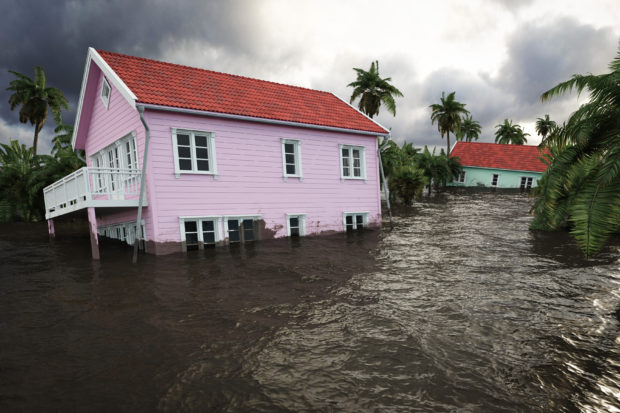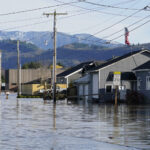U.S. senators from coastal states are predicting “an actuarial disaster” in the future once FEMA’s new flood insurance rating systems goes into full swing.
In a press call on Sept. 30, Louisiana Sen. Bill Cassidy and New Jersey Sen. Bob Menendez called for President Biden to delay the implementation of the National Flood Insurance Program’s new rating system, Risk Rating 2.0, which went into effect on Oct. 1.
Cassidy acknowledged the new methodology would go into effect. However, he said that his “personal plea is that the president would tell FEMA not to proceed with Risk Rating 2.0. but to look for alternatives.”
Cassidy and Menendez held their press call just days after announcing they, along with U.S. Senators Marco Rubio (R-FL), Cindy Hyde-Smith (R-MS) and John Cornyn (R-TX), had introduced legislation to delay the rollout of the new risk rating methodology they say would result in flood insurance rate hikes for residents in their states. NFIP Risk Rating 2.0 Delay Act of 2021 would have required FEMA, which manages the NFIP, to delay that agency’s Risk Rating 2.0 rollout until Sept. 30, 2022.
Cassidy and Menendez said their ultimate goal is to inspire Congress to act on reform proposals to revamp the flood insurance program.
They believe the new rating system, which calls for year-over-year rate increases capped at 18 percent for at least the next decade, will raise rates to a point that they will not be sustainable for policyholders and therefore the NFIP.
Cassidy said in the press call that an as-yet-unpublished evaluation by the Congressional Budget Office anticipates that as many as “900,000 policyholders in the NFIP would end up dropping their coverage” over the course of 10 years. “That’s about one-fifth of the policyholders,” Cassidy said.
“FEMA is saying that only 66 percent of the policies will see increases of $0-$10 per month. But this is actually a little misleading. I’m looking at a quote from Lake Charles, La., from someone who does not live in a flood zone. Their policy rises from about $570 now to about $5,200 over the course of about 10-15 years. you can say that’s a long time, but he’s not in a flood zone,” Cassidy said in the press call.
Menendez said the statutory cap of 18 percent per year will result in increases that are higher than the “annual 6-12 percent increases that policyholders have become accustomed to.” He said that while “18 percent may look manageable to some in year one, it becomes very unmanageable when those 18 percent increases continuously compound for years to come…In four short years, 18 percent compounding increases…a premium to nearly double. This is why we need the pause.”
Cassidy and Menendez both decried what they said is the lack of transparency surrounding the rollout of Risk Rating 2.0. Neither policyholders nor insurance agents have been properly educated on the changes and the effect the new methodology will have on consumers, they said.
According to an Associated Press report, Independent Insurance Agents and Brokers of Louisiana was unsuccessful with its request for rate charts showing the long-term pricing changes.
“They said, ‘We don’t have that put together yet,'” organization CEO Jeff Albright told the AP. “How do you make that decision without having the full information?”
The AP also reported that up to 80 percent of the 496,000 NFIP policies in Louisiana would likely see price hikes in the first year.
It’s the rate increases that compound over time that will cause the “actuarial disaster,” Cassidy said. “You have fewer policyholders that are lower risk…therefore you have to concentrate the price increases among those that are at higher risk. But progressively more of them drop coverage because they can’t afford the increased premium—which continues the cycle of an actuarial death spiral…Eventually the program becomes unsustainable.”
Menendez said he supports “revamping our flood insurance rating system to include the most sophisticated data including data on climate change. While I tried to give FEMA space to develop its new rating system and want to be supportive of a process to achieve that, Risk Rating 2.0 as it stands needs to be delayed.”
The senators also want Congress to “fund robust mitigation to better protect homeowners from the next storm. For every dollar we spend on mitigation, the government saves six dollars on the back end. Putting the program on a path to solvency,” Menendez said.
Risk Rating 2.0 represents the first time FEMA has revised its pricing methodology for flood risks since the 1970s. Traditionally, rates for the NFIP “have been predominantly based on relatively static measurements, emphasizing a property’s elevation within a zone on a Flood Insurance Rate Map (FIRM),” FEMA said in a message on its website.
Risk Rating 2.0 will roll out in two phases. In phase one, beginning on Oct. 1, 2021, new policies, as well as policies eligible for renewal on that date, will be subject to the new rating methodology, FEMA said. In phase two, policies renewing on or after April 1, 2022, will be issued under Risk Rating 2.0 methodology.
Current NFIP limits for residential coverages are $250,000 for the structure and $100,000 for the contents. For commercial structures, limits are $500,000 for the building and $500,000 for the content.





















 Good Times for U.S. P/C Insurers May Not Last; Auto Challenges Ahead
Good Times for U.S. P/C Insurers May Not Last; Auto Challenges Ahead  Nearly Half of 100 Largest P/C Insurers Destroy Value: ACORD
Nearly Half of 100 Largest P/C Insurers Destroy Value: ACORD  California Workers Comp Combined Ratio for 2024 Highest in 20-Plus Years
California Workers Comp Combined Ratio for 2024 Highest in 20-Plus Years  Berkshire Hathaway Enters Post-Buffett Era as Share Prices Fall
Berkshire Hathaway Enters Post-Buffett Era as Share Prices Fall 






